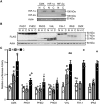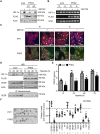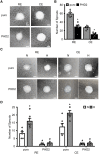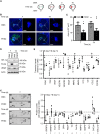Gene Transfer of Prolyl Hydroxylase Domain 2 Inhibits Hypoxia-inducible Angiogenesis in a Model of Choroidal Neovascularization
- PMID: 28186209
- PMCID: PMC5301234
- DOI: 10.1038/srep42546
Gene Transfer of Prolyl Hydroxylase Domain 2 Inhibits Hypoxia-inducible Angiogenesis in a Model of Choroidal Neovascularization
Abstract
Cellular responses to hypoxia are mediated by the hypoxia-inducible factors (HIF). In normoxia, HIF-α proteins are regulated by a family of dioxygenases, through prolyl and asparagyl hydroxylation, culminating in proteasomal degradation and transcriptional inactivation. In hypoxia, the dioxygenases become inactive and allow formation of HIF transcription factor, responsible for upregulation of hypoxia genes. In ocular neoangiogenic diseases, such as neovascular age-related macular degeneration (nAMD), hypoxia seems pivotal. Here, we investigate the effects of HIF regulatory proteins on the hypoxia pathway in retinal pigment epithelium (RPE) cells, critically involved in nAMD pathogenesis. Our data indicates that, in ARPE-19 cells, prolyl hydroxylase domain (PHD)2 is the most potent negative-regulator of the HIF pathway. The negative effects of PHD2 on the hypoxia pathway were associated with decreased HIF-1α protein levels, and concomitant decrease in angiogenic factors. ARPE-19 cells stably expressing PHD2 impaired angiogenesis in vitro by wound healing, tubulogenesis, and sprouting assays, as well as in vivo by iris-induced angiogenesis. Gene transfer of PHD2 in vivo resulted in mitigation of HIF-mediated angiogenesis in a mouse model of nAMD. These results may have implications for the clinical treatment of nAMD patients, particularly regarding the use of gene therapy to negatively regulate neoangiogenesis.
Conflict of interest statement
The authors declare no competing financial interests.
Figures







Similar articles
-
Inhibition of Hypoxia-Induced Retinal Angiogenesis by Specnuezhenide, an Effective Constituent of Ligustrum lucidum Ait., through Suppression of the HIF-1α/VEGF Signaling Pathway.Molecules. 2016 Dec 21;21(12):1756. doi: 10.3390/molecules21121756. Molecules. 2016. PMID: 28009852 Free PMC article.
-
Decorin inhibits angiogenic potential of choroid-retinal endothelial cells by downregulating hypoxia-induced Met, Rac1, HIF-1α and VEGF expression in cocultured retinal pigment epithelial cells.Exp Eye Res. 2013 Nov;116:151-60. doi: 10.1016/j.exer.2013.08.019. Epub 2013 Sep 6. Exp Eye Res. 2013. PMID: 24016866
-
Echinomycin mitigates ocular angiogenesis by transcriptional inhibition of the hypoxia-inducible factor-1.Exp Eye Res. 2021 May;206:108518. doi: 10.1016/j.exer.2021.108518. Epub 2021 Feb 25. Exp Eye Res. 2021. PMID: 33639134
-
Impaired Neovascularization in Aging.Adv Wound Care (New Rochelle). 2020 Mar 1;9(3):111-126. doi: 10.1089/wound.2018.0912. Epub 2020 Jan 24. Adv Wound Care (New Rochelle). 2020. PMID: 31993253 Free PMC article. Review.
-
Hypoxia-induced erythropoietin production: a paradigm for oxygen-regulated gene expression.Clin Exp Pharmacol Physiol. 2006 Oct;33(10):968-79. doi: 10.1111/j.1440-1681.2006.04474.x. Clin Exp Pharmacol Physiol. 2006. PMID: 17002676 Review.
Cited by
-
Prolyl hydroxylase domain 3 influences the radiotherapy efficacy of pancreatic cancer cells by targeting hypoxia-inducible factor-1α.Onco Targets Ther. 2018 Nov 29;11:8507-8515. doi: 10.2147/OTT.S187615. eCollection 2018. Onco Targets Ther. 2018. PMID: 30555241 Free PMC article.
-
Intussusceptive Vascular Remodeling Precedes Pathological Neovascularization.Arterioscler Thromb Vasc Biol. 2019 Jul;39(7):1402-1418. doi: 10.1161/ATVBAHA.118.312190. Epub 2019 May 9. Arterioscler Thromb Vasc Biol. 2019. PMID: 31242036 Free PMC article.
-
A simplified protocol to induce hypoxia in a standard incubator: A focus on retinal cells.Exp Eye Res. 2023 Nov;236:109653. doi: 10.1016/j.exer.2023.109653. Epub 2023 Oct 2. Exp Eye Res. 2023. PMID: 37793495 Free PMC article.
-
The Different Facades of Retinal and Choroidal Endothelial Cells in Response to Hypoxia.Int J Mol Sci. 2018 Dec 3;19(12):3846. doi: 10.3390/ijms19123846. Int J Mol Sci. 2018. PMID: 30513885 Free PMC article. Review.
-
UPARANT is an effective antiangiogenic agent in a mouse model of rubeosis iridis.J Mol Med (Berl). 2019 Sep;97(9):1273-1283. doi: 10.1007/s00109-019-01794-w. Epub 2019 Jun 26. J Mol Med (Berl). 2019. PMID: 31243519 Free PMC article.
References
-
- Ruas J. L. & Poellinger L. Hypoxia-dependent activation of HIF into a transcriptional regulator. Semin. Cell Dev. Biol. 16, 514–522 (2005). - PubMed
-
- Weidemann A. & Johnson R. S. Biology of HIF-1α. Cell Death Differ 15, 621–627 (2008). - PubMed
-
- Wang G. L. & Semenza G. L. Purification and characterization of hypoxia-inducible factor 1. J. Biol. Chem. 270, 1230–1237 (1995). - PubMed
Publication types
MeSH terms
Substances
LinkOut - more resources
Full Text Sources
Other Literature Sources

